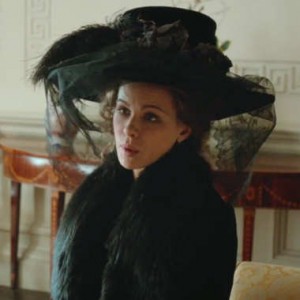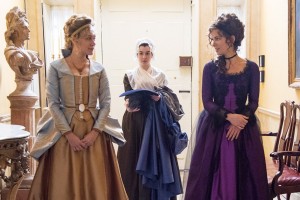Interview: Whit Stillman on Adapting Jane Austen in “Love & Friendship”
Posted on May 18, 2016 at 3:37 pm
Whit Stillman is known for his elegant, shrewd, and witty drawing-room comedies about the upper classes, which makes him a natural for adapting Jane Austen. His new film is called “Love & Friendship,” the title of an early Jane Austen novel, but it is based on a different book, the epistolary (told in letters) story of a widow described as “the most accomplished coquette in England.” Lady Susan is played by Kate Beckinsale and her close friend, an American, is played by Stillman favorite Chloe Sevigny. In an interview, Stillman talked about using costumes and music to tell the story and why it took him a few years to appreciate Austen.
How was it adapting a novel told through letters instead of a traditional narrative?
I try to keep the letters to a minimum in it, because it could have been dominated by the letter format, so I had to stay away from that and try to make it pay off when it was used. It’s a long process and it takes a long time. It’s one thing to adapt a novel when you have the scenes and the dialogue from the scenes and you can the novel as written. In this case you had to kind of recast everything, shuffle the deck, and take at least two letters back and forth to make a dialogue scene between two people or various people. It could be more than five letters going into one scene with parts used in another scene. It requires some invention of additional characters and then those characters have their lives and preconceptions and their stories. Although people probably talk about the funny lines in their film and dialogue, everything in film has to be about the story and so it’s all leading to developments and story and characters and where they want to end up and where they’re going to end up.
The costumes are gorgeous.
Eimer Ni Mhaoldomhnaigh, who did the costumes, was one of the first crew names mentioned to me and was the first person of the crew we hired. She was also helpful with many of the other people who were very good in each department. We were talking about the period that it was earlier than what people think of as Jane Austen, the 1790s. It’s a little bit of a broad reach because we think she started writing in 1793 but she didn’t make a clean copy till 1805. So we thought that well if there are things we like in the earlier period we would use them and also the older people could be wearing things from the past and I don’t really like the lines of the later styles. Ladies’ fashion of this period gave us the opportunity to make Lady Susan and her friend, played by Kate and Chloe look sexy and interesting. Lady Susan was a widow and this whole thing of her widowhood was reflected in her clothes. She’s all in black with a veil the first time she is seen and that comes off and she seems sexier and sexier and the colours change over time. So that was Lady Susan’s progression and then the idea for Chloe was more cheerful, bright and colorful. We were down in costume departments in London for a lot of the male actors to make sure we were choosing the right costumes and right livery for the footman and everything.
Why did you switch the title?
I really believe like when you are making film just do everything the best you can. So if you don’t like the title, change it and I didn’t like the title at all. I really hated it and very early like right away when I started working on the adaptation I said I’m not going to work on a film called “Lady Susan” and I had seen Love and Freindship(sic) as one of her other titles and so I immediately titled it “Love and Friendship.” I’m surprised when people asked me, why did you re-title it? For me that’s twelve years old. She had this very Austenian title on a juvenilia story that’s not fascinating. She misspelt friendship and all that. So I thought it was good to have it in the Austenian later tradition. It’s the direction she generally went in. At first I didn’t think that the title bore any relationship to the story. After I finished the film actually I think the title is in the story.
In your first film, Metropolitan, the characters discuss Mansfield Park. So have you been an Austen fan for a long time?

I think your Lady Susan is more sympathetic than the one in the book, maybe because Kate Beckinsale plays her so charmingly. She is still manipulative and deceptive, but we can see the reason for it.
She’s not virtuous and but she wants to achieve things that are understandable. She sure wants to achieve them fairly dishonestly. But what she actually does ends up being positive for everyone and with a catalyst it doesn’t really matter what they want to do; it matters how they affect the rest of the world. She’s kind of like that bird on the rhinoceros. She eats the bugs and helps him while she’s riding on his back.
